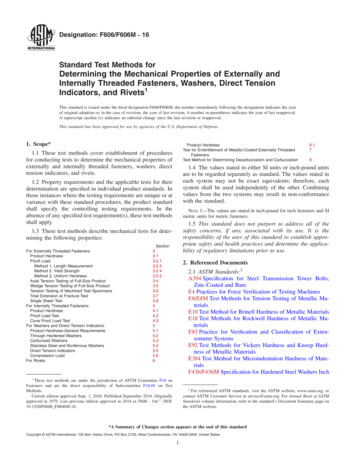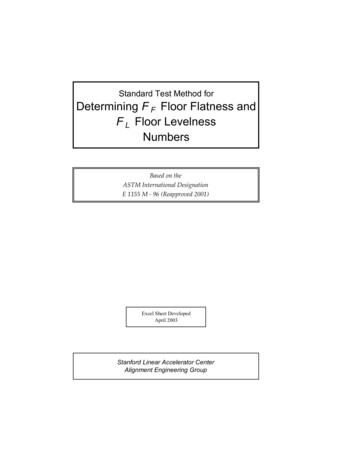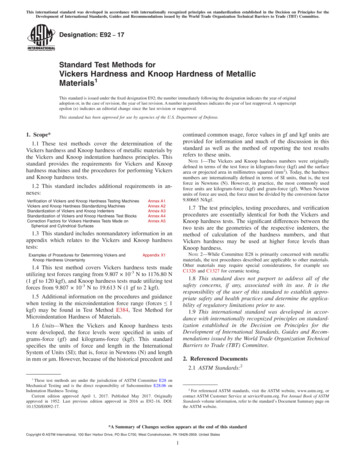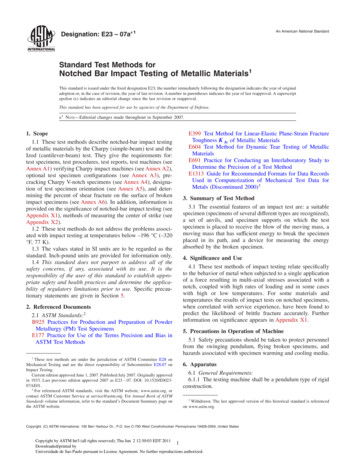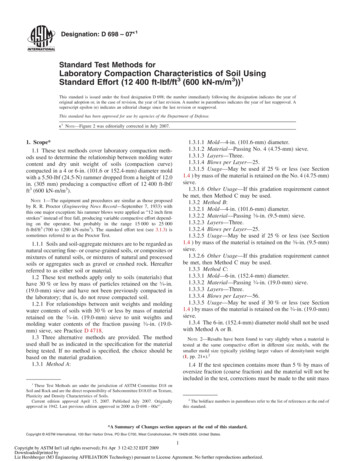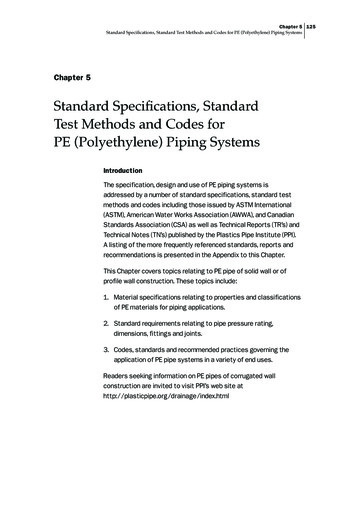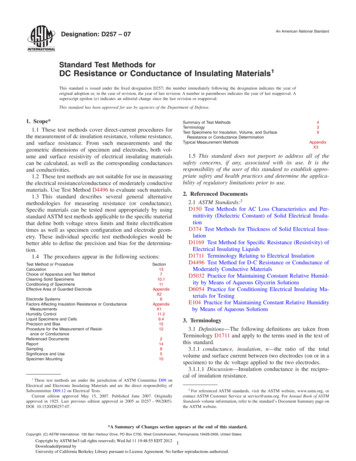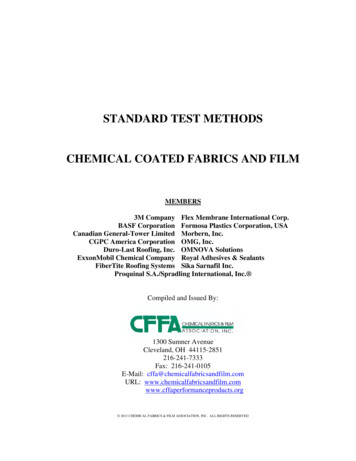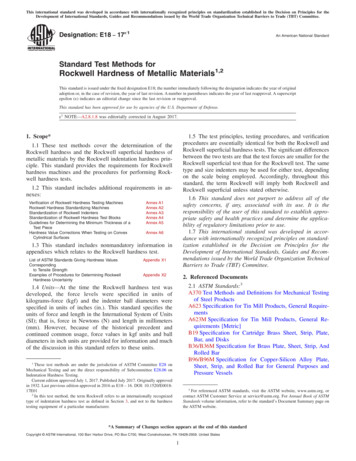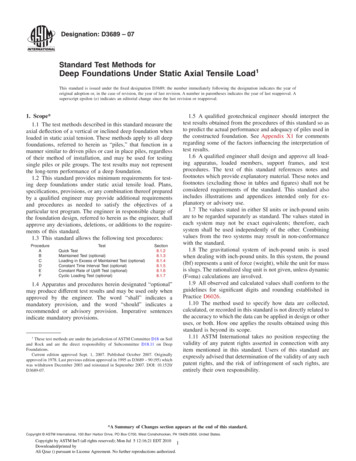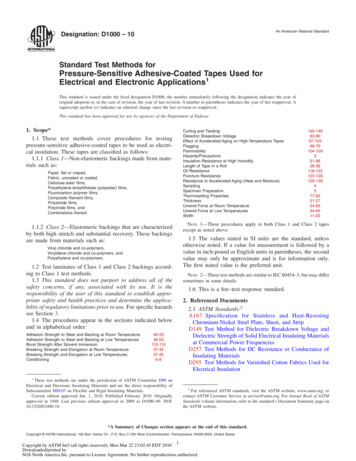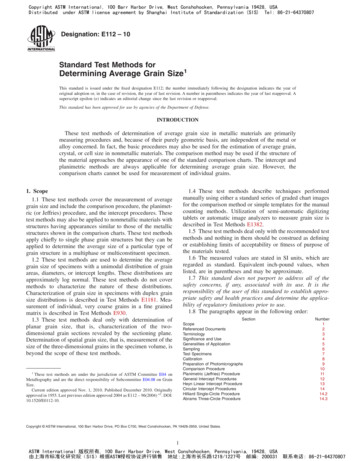
Transcription
Copyright ASTM International, 100 Barr Harbor Drive, West Conshohocken, Pennsylvania 19428, USADistributed under ASTM license agreement by Shanghai Institute of Standardization (SIS) Tel: 86-21-64370807Designation: E112 – 10Standard Test Methods forDetermining Average Grain Size1This standard is issued under the fixed designation E112; the number immediately following the designation indicates the year oforiginal adoption or, in the case of revision, the year of last revision. A number in parentheses indicates the year of last reapproval. Asuperscript epsilon ( ) indicates an editorial change since the last revision or reapproval.This standard has been approved for use by agencies of the Department of Defense.INTRODUCTIONThese test methods of determination of average grain size in metallic materials are primarilymeasuring procedures and, because of their purely geometric basis, are independent of the metal oralloy concerned. In fact, the basic procedures may also be used for the estimation of average grain,crystal, or cell size in nonmetallic materials. The comparison method may be used if the structure ofthe material approaches the appearance of one of the standard comparison charts. The intercept andplanimetric methods are always applicable for determining average grain size. However, thecomparison charts cannot be used for measurement of individual grains.1.4 These test methods describe techniques performedmanually using either a standard series of graded chart imagesfor the comparison method or simple templates for the manualcounting methods. Utilization of semi-automatic digitizingtablets or automatic image analyzers to measure grain size isdescribed in Test Methods E1382.1.5 These test methods deal only with the recommended testmethods and nothing in them should be construed as definingor establishing limits of acceptability or fitness of purpose ofthe materials tested.1.6 The measured values are stated in SI units, which areregarded as standard. Equivalent inch-pound values, whenlisted, are in parentheses and may be approximate.1.7 This standard does not purport to address all of thesafety concerns, if any, associated with its use. It is theresponsibility of the user of this standard to establish appropriate safety and health practices and determine the applicability of regulatory limitations prior to use.1.8 The paragraphs appear in the following order:1. Scope1.1 These test methods cover the measurement of averagegrain size and include the comparison procedure, the planimetric (or Jeffries) procedure, and the intercept procedures. Thesetest methods may also be applied to nonmetallic materials withstructures having appearances similar to those of the metallicstructures shown in the comparison charts. These test methodsapply chiefly to single phase grain structures but they can beapplied to determine the average size of a particular type ofgrain structure in a multiphase or multiconstituent specimen.1.2 These test methods are used to determine the averagegrain size of specimens with a unimodal distribution of grainareas, diameters, or intercept lengths. These distributions areapproximately log normal. These test methods do not covermethods to characterize the nature of these distributions.Characterization of grain size in specimens with duplex grainsize distributions is described in Test Methods E1181. Measurement of individual, very coarse grains in a fine grainedmatrix is described in Test Methods E930.1.3 These test methods deal only with determination ofplanar grain size, that is, characterization of the twodimensional grain sections revealed by the sectioning plane.Determination of spatial grain size, that is, measurement of thesize of the three-dimensional grains in the specimen volume, isbeyond the scope of these test methods.SectionScopeReferenced DocumentsTerminologySignificance and UseGeneralities of ApplicationSamplingTest SpecimensCalibrationPreparation of PhotomicrographsComparison ProcedurePlanimetric (Jeffries) ProcedureGeneral Intercept ProceduresHeyn Linear Intercept ProcedureCircular Intercept ProceduresHilliard Single-Circle ProcedureAbrams Three-Circle Procedure1These test methods are under the jurisdiction of ASTM Committee E04 onMetallography and are the direct responsibility of Subcommittee E04.08 on GrainSize.Current edition approved Nov. 1, 2010. Published December 2010. Originallyapproved in 1955. Last previous edition approved 2004 as E112 – 96(2004) 2. 14.3Copyright ASTM International, 100 Barr Harbor Drive, PO Box C700, West Conshohocken, PA 19428-2959, United States.1ASTM International 版权所有, 100 Barr Harbor Drive, West Conshohocken, Pennsylvania, 19428, TM授权协议进行销售 地址:上海市长乐路1219/1227号 邮编: 200031联系电话: 86-21-64370807
Copyright ASTM International, 100 Barr Harbor Drive, West Conshohocken, Pennsylvania 19428, USADistributed under ASTM license agreement by Shanghai Institute of Standardization (SIS) Tel: 86-21-64370807E112 – 10Statistical AnalysisSpecimens with Non-equiaxed Grain ShapesSpecimens Containing Two or More Phases or ConstituentsReportPrecision and BiasKeywordsAnnexes:Basis of ASTM Grain Size Numbersing twin boundaries, the twin boundaries are ignored, that is,the structure on either side of a twin boundary belongs to thegrain.3.2.3 grain boundary intersection count—determination ofthe number of times a test line cuts across, or is tangent to,grain boundaries (triple point intersections are considered as1-1 2 intersections).3.2.4 grain intercept count—determination of the number oftimes a test line cuts through individual grains on the plane ofpolish (tangent hits are considered as one half an interception;test lines that end within a grain are considered as one half aninterception).3.2.5 intercept length—the distance between two opposed,adjacent grain boundary intersection points on a test linesegment that crosses the grain at any location due to randomplacement of the test line.3.3 Symbols:Symbols:151617181920AnnexA1Equations for Conversions Among Various Grain Size Measurements AnnexA2Austenite Grain Size, Ferritic and Austenitic SteelsAnnexA3Fracture Grain Size MethodAnnexA4Requirements for Wrought Copper and Copper-Base AlloysAnnexA5Application to Special SituationsAnnexA6Appendixes:Results of Interlaboratory Grain Size DeterminationsAppendix X1Referenced AdjunctsAppendix X22. Referenced Documents2.1 ASTM Standards:2E3 Guide for Preparation of Metallographic SpecimensE7 Terminology Relating to MetallographyE407 Practice for Microetching Metals and AlloysE562 Test Method for Determining Volume Fraction bySystematic Manual Point CountE691 Practice for Conducting an Interlaboratory Study toDetermine the Precision of a Test MethodE883 Guide for Reflected Light PhotomicrographyE930 Test Methods for Estimating the Largest Grain Observed in a Metallographic Section (ALA Grain Size)E1181 Test Methods for Characterizing Duplex Grain SizesE1382 Test Methods for Determining Average Grain SizeUsing Semiautomatic and Automatic Image Analysis2.2 ASTM Adjuncts:2.2.1 For a complete adjunct list, see Appendix X2aA—AAI,—d—DfG—,—,a—,,—,t3. Terminology3.1 Definitions—For definitions of terms used in these testmethods, see Terminology E7.3.2 Definitions of Terms Specific to This Standard:3.2.1 ASTM grain size number—the ASTM grain sizenumber, G, was originally defined as:NAE 5 2G21—,p,0(1)where NAE is the number of grains per square inch at 100Xmagnification. To obtain the number per square millimetre at1X, multiply by 15.50.3.2.2 grain—that area within the confines of the original(primary) boundary observed on the two-dimensional planeof-polish or that volume enclosed by the original (primary)boundary in the three-dimensional object. In materials contain-LMMbnNaNANAa2For referenced ASTM standards, visit the ASTM website, www.astm.org, orcontact ASTM Customer Service at service@astm.org. For Annual Book of ASTMStandards volume information, refer to the standard’s Document Summary page onthe ASTM website. matrix grains in a two phase (constituent)microstructure. test area. mean grain cross sectional area. grain elongation ratio or anisotropy indexfor a longitudinally oriented plane. mean planar grain diameter (Plate III). mean spatial (volumetric) grain diameter. Jeffries multiplier for planimetric method. ASTM grain size number. mean lineal intercept length. mean lineal intercept length of the amatrix phase in a two phase (constituent)microstructure. mean lineal intercept length on a longitudinally oriented surface for a nonequiaxed grain structure. mean lineal intercept length on a transversely oriented surface for a nonequiaxed grain structure. mean lineal intercept length on a planaroriented surface for a non-equiaxed grainstructure. base intercept length of 32.00 mm fordefining the relationship between G and ,(and NL ) for macroscopically or microscopically determined grain size by theintercept method. length of a test line. magnification used. magnification used by a chart pictureseries. number of fields measured. number of a grains intercepted by the testline in a two phase (constituent) microstructure. number of grains per mm2 at 1X. number of a grains per mm2 at 1X in atwo phase (constituent) microstructure.2ASTM International 版权所有, 100 Barr Harbor Drive, West Conshohocken, Pennsylvania, 19428, TM授权协议进行销售 地址:上海市长乐路1219/1227号 邮编: 200031联系电话: 86-21-64370807
Copyright ASTM International, 100 Barr Harbor Drive, West Conshohocken, Pennsylvania 19428, USADistributed under ASTM license agreement by Shanghai Institute of Standardization (SIS) Tel: 86-21-64370807E112 – 10NAENA,N AtNApNiNInsideN InterceptedNLN L,NLtNLpPiPLPL,PLtPLpQQmsSVSVatVVa95 % CI% RA4.1.1 Comparison Procedure—The comparison proceduredoes not require counting of either grains, intercepts, orintersections but, as the name suggests, involves comparison ofthe grain structure to a series of graded images, either in theform of a wall chart, clear plastic overlays, or an eyepiecereticle. There appears to be a general bias in that comparisongrain size ratings claim that the grain size is somewhat coarser(1 2 to 1 G number lower) than it actually is (see X1.3.5).Repeatability and reproducibility of comparison chart ratingsare generally 61 grain size number.4.1.2 Planimetric Procedure—The planimetric method involves an actual count of the number of grains within a knownarea. The number of grains per unit area, NA , is used todetermine the ASTM grain size number, G. The precision ofthe method is a function of the number of grains counted. Aprecision of 60.25 grain size units can be attained with areasonable amount of effort. Results are free of bias andrepeatability and reproducibility are less than 60.5 grain sizeunits. An accurate count does require marking off of the grainsas they are counted.4.1.3 Intercept Procedure—The intercept method involvesan actual count of the number of grains intercepted by a testline or the number of grain boundary intersections with a testline, per unit length of test line, used to calculate the mean—lineal intercept length, —, . , is used to determine the ASTMgrain size number, G. The precision of the method is a functionof the number of intercepts or intersections counted. A precision of better than 60.25 grain size units can be attained witha reasonable amount of effort. Results are free of bias;repeatability and reproducibility are less than 60.5 grain sizeunits. Because an accurate count can be made without need ofmarking off intercepts or intersections, the intercept method isfaster than the planimetric method for the same level ofprecision.4.2 For specimens consisting of equiaxed grains, themethod of comparing the specimen with a standard chart ismost convenient and is sufficiently accurate for most commercial purposes. For higher degrees of accuracy in determiningaverage grain size, the intercept or planimetric procedures maybe used. The intercept procedure is particularly useful forstructures consisting of elongated grains.4.3 In case of dispute, the intercept procedure shall be thereferee procedure in all cases.4.4 No attempt should be made to estimate the average grainsize of heavily cold-worked material. Partially recrystallizedwrought alloys and lightly to moderately cold-worked materialmay be considered as consisting of non-equiaxed grains, if agrain size measurement is necessary.4.5 Individual grain measurements should not be madebased on the standard comparison charts. These charts wereconstructed to reflect the typical log-normal distribution ofgrain sizes that result when a plane is passed through athree-dimensional array of grains. Because they show a distribution of grain dimensions, ranging from very small to verylarge, depending on the relationship of the planar section andthe three-dimensional array of grains, the charts are notapplicable to measurement of individual grains. number of grains per inch2 at 100X. NA on a longitudinally oriented surface fora non-equiaxed grain structure. NA on a transversely oriented surface for anon-equiaxed grain structure. NA on a planar oriented surface for anon-equiaxed grain structure. number of intercepts with a test line. number of grains completely within a testcircle. number of grains intercepted by the testcircle. number of intercepts per unit length oftest line. NL on a longitudinally oriented surface fora non-equiaxed grain structure. NL on a transversely oriented surface for anon-equiaxed grain structure. NL on a planar oriented surface for anon-equiaxed grain structure. number of grain boundary intersectionswith a test line. number of grain boundary intersectionsper unit length of test line. PL on a longitudinally oriented surface fora non-equiaxed grain structure. PL on a transversely oriented surface for anon-equiaxed grain structure. PL on a planar oriented surface for anon-equiaxed grain structure. cor
the ASTM website. E112 – 10 2 &RS\ULJKW 670,QWHUQDWLRQDO %DUU DUERU'ULYH :HVW&RQVKRKRFNHQ 3HQQV\OYDQLD 86 'LVWULEXWHGXQGHU DWLRQ 6,6 7HO 670,QWHUQDWLRQDO( Ý %DUU DUERU'ULYH :HVW&RQVKRKRFNHQ
